In the early 1960s, General Electric developed a technology called thin-film electronics.1 These circuits were built from thin films of material, much more compact than individual components. For weight-sensitive applications such as satellites and military equipment, thin-film electronics could potentially be revolutionary.
GE's Light Military Electronics department1 built the paperweight above to showcase their "Space Age Electronics". In the center is a thin-film circuit, next to a model of an early satellite. However, the paperweight contained a surprise: when picked up, the paperweight emitted a beep-beep-beep noise, sounding just like a satellite.2 In this blog post, I reverse-engineer the "Space Age Electronics" inside this paperweight and explain how it works. In brief, the visible thin-film circuit implements a flip flop. The remaining circuitry is hidden in the compartment on the left: two oscillators that produce the beeps. These oscillators are implemented in another unusual 1960s technique called "cordwood'.
The thin-film module
The most visible part of the paperweight is the thin-film module. The idea behind thin film is to build resistors and capacitors as thin layers on a substrate, rather than using individual components. Resistors are formed from thin strips of resistive material, the vertical reddish-brown lines on the module's surface. For higher resistance, these lines zig-zag back and forth.3 Capacitors are formed from two thin layers of metal (the plates), separated by an insulating dielectric material.
Thin-film transistors were not commercially practical in the 1960s, so the module has tiny discrete transistors and diodes mounted on top, connected by golden wires. (This must have been expensive to manufacture.) In the photo above, the shadows show that the semiconductor components (black blobs) are slightly above the surface. You can distinguish the diodes by their green dots. At the left, five metallic strips provide power and signal connections to the module, with golden contacts connecting these strips to the thin-film circuitry.
Interest in thin-film technology declined in the mid-1960s as integrated circuits became commercially available. Integrated circuits were cheaper, could fit more components into a chip, and could be mass-produced. For these reasons, integrated circuits took over the electronics market. Thin-film circuits are still used, but only for specialized applications.
I traced out the paperweight's thin-film circuit and found that it implements a toggle flip flop, a standard electronic circuit. The flip flop stores either a 1 state or a 0 state, like a single bit of memory. When it gets a negative pulse on the trigger input, it flips to the opposite state. Thus, as it receives input pulses, it goes "on", "off", "on", "off", etc. In the paperweight, the flip flop creates the separate beeps. The paperweight generates a beep while the flip flop is on, and is silent when the flip flop is off.
You can match up the components in the schematic with the components in the photo: two transistors, two diodes, four capacitors, and multiple resistors. Note that the two sides of the circuit are symmetrical, both in the schematic and in the photo. One side of the circuit is on and one side is off. Depending on which side is on, the circuit holds a 0 or a 1. See the footnote4 for more details.
Inside the paperweight
The left side of the paperweight has a compartment with some interesting circuitry inside. The paperweight was powered by a 22½ V battery, which was relatively common back then but is now obsolete. It looks a bit like a 9-volt battery, except it has one contact at each end. Next to the battery is a vintage earphone, the round pink component. It acts as the speaker in this device.
Another unusual component is the tilt switch in the lower right, which turns the paperweight on and off. (I don't know if this tilt switch contains mercury or has a rolling ball inside.) When the paperweight is horizontal, the tilt switch is open. But if the paperweight is picked up, the tilt switch closes. This probably added to the "drama" of the paperweight, since someone will think it is just a decoration until they pick it up and it starts beeping.
In the upper right of the compartment, a block of plastic encases the oscillator circuitry. The module is built with "cordwood" construction, a way of building high-density circuits that was popular in the 1960s. Instead of mounting components flat on a circuit board, cordwood puts components between two boards. (They are stacked together like logs, giving cordwood its name.) The photo below shows the components; it isn't as clear as I'd like because the components are embedded in yellowing plastic.
On each side of the module, components are wired with point-to-point wiring, as shown below. This photo also shows how the insulated connection wires are also embedded in the module. The large dark circles are the two transistors.
The oscillators use unijunction transistors, a somewhat unusual type of transistor, different from standard NPN and PNP transistors. Oscillators could be easily created from unijunction transistors due to their nonlinear characteristics. The unijunction transistor was invented by General Electric in 1953, so it's not surprising that General Electric made use of them in this paperweight. The GE logo is visible on top of the transistors.
The cordwood block holds two oscillators, to control the duration of each beep and to generate the beep sound itself. The first oscillator generates five pulses per second. These pulses go to the thin-film flip-flop circuit, which will change its state between off and on with each pulse. That is, the flip flop is off for 200 milliseconds, on for 200 milliseconds, and so forth. The output from the flip flop powers the second transistor oscillator, which generates a 3.5-kilohertz tone. The result is the repeating beep-beep-beep output from the paperweight.
The schematic above shows the two oscillators. The idea behind a unijunction transistor oscillator is that the capacitor slowly charges through the resistor. As the capacitor charges, the voltage on the emitter (symbolized by the arrow) increases. When it reaches the trigger voltage, the transistor turns on and the capacitor discharges to ground. The cycle repeats, generating a sequence of pulses on the output.
Conclusion
I think the paperweight is from approximately 1962, based on GE's thin-film research at the time and the appearance of the paperweight's model satellite.6 The paperweight was produced in the midst of the space race; John Glenn became the first American in orbit in 1962. Satellites were still a new "space-age" thing at the time, so the paperweight was a symbol of General Electric's advanced technology.5 The beeps from the paperweight are similar to those produced by Sputnik (1957). At the time, the paperweight must have been an impressive object, a vision of the future.
Thanks to Peter B. Newman, technology collector and educator for sending me the paperweight for analysis. Thanks to Mikes Electric Stuff for identifying the tilt switch for me.
I announce my latest blog posts on Twitter, so follow me @kenshirriff. I also have an RSS feed.
Notes and references
-
The paperweight was built by GE's Light Military Electronics department. In the early 1960s, this department produced aerospace electronics such as digital guidance computers, flight-control systems, and satellite sensors. These were used in weapons including the F-105 fighter-bomber, Sidewinder missile, and Polaris and Atlas ICBMs. ↩↩
-
Sputnik's beeps were approximately 150-300 ms long at 1.5 kilohertz. (The frequency isn't well-defined because the transmission was just a carrier switched on and off, but this is the frequency in typical recordings.) The paperweight's beeps were approximately 200 ms long at 3.47 kilohertz. The point is that the paperweight's beeps were designed to resemble the beeps from a satellite such as Sputnik, and people would have recognized this at the time. You can hear the beeps of the paperweight here; I had to edit the audio a bit because I discovered too late that the doorbell rang in the middle of the recording. ↩
-
In the module, some of the resistors are connected to the metal layer through structures that have teeth kind of like a comb. I'm not sure what the purpose of these structures is. My hypothesis is that by changing the number of "teeth", the active length of the resistor can be changed, adjusting the resistor. (Modifying the metal layer is easier than modifying the thin-film layers.) ↩
-
The two transistors are cross-connected, so when one transistor is on, it forces the other one off. The trigger capacitors are pre-charged through the corresponding output. The result is that the transistor that is currently on (output low) will be pulled lower than the transistor that is currently off (output high). This turns off the first transistor, flipping the state of the circuit. It's a fairly standard flip-flop circuit; more details are here. ↩
-
In 1960, GE hoped to build a commercial communications satellite network, and formed a subsidiary "Communication Satellites Inc" in 1960. However, GE abandoned that goal in 1961 (probably due to antitrust issues) to focus on manufacturing equipment for space vehicles. ↩
-
The satellite in the paperweight resembles the Ariel 1 (1962) and Ariel 2 (1964) satellites, with its paddle-like solar cells. It's not an exact match, so I don't know if the satellite is an artist's conception, or is a different satellite. If you recognize the satellite, please let me know. ↩
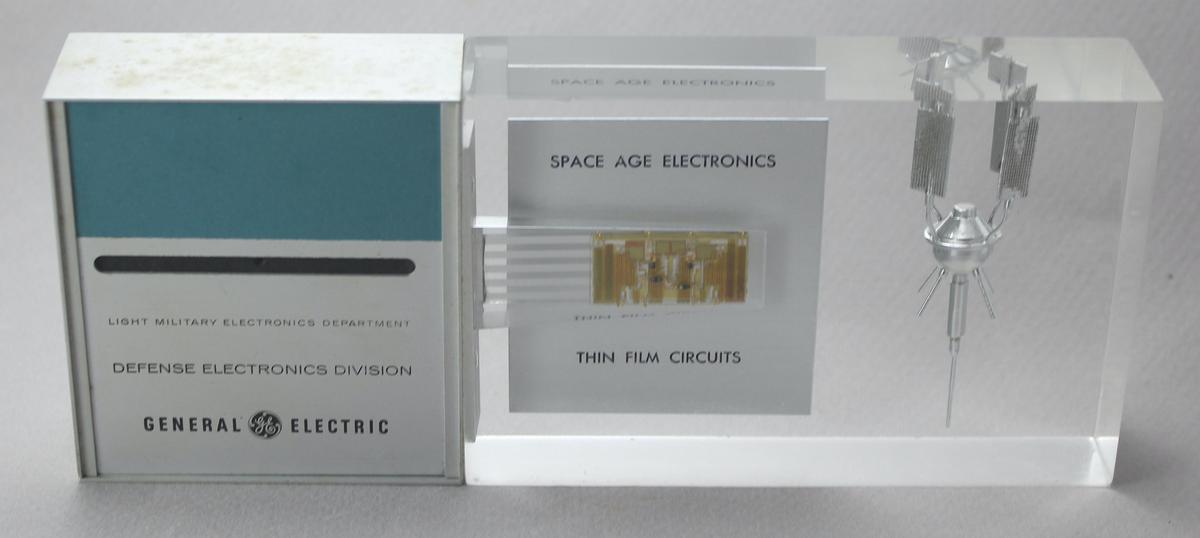
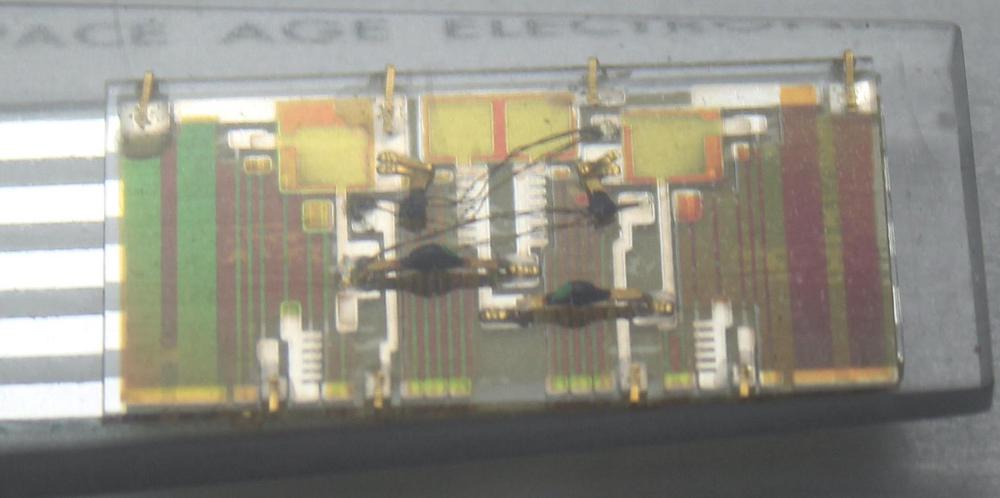
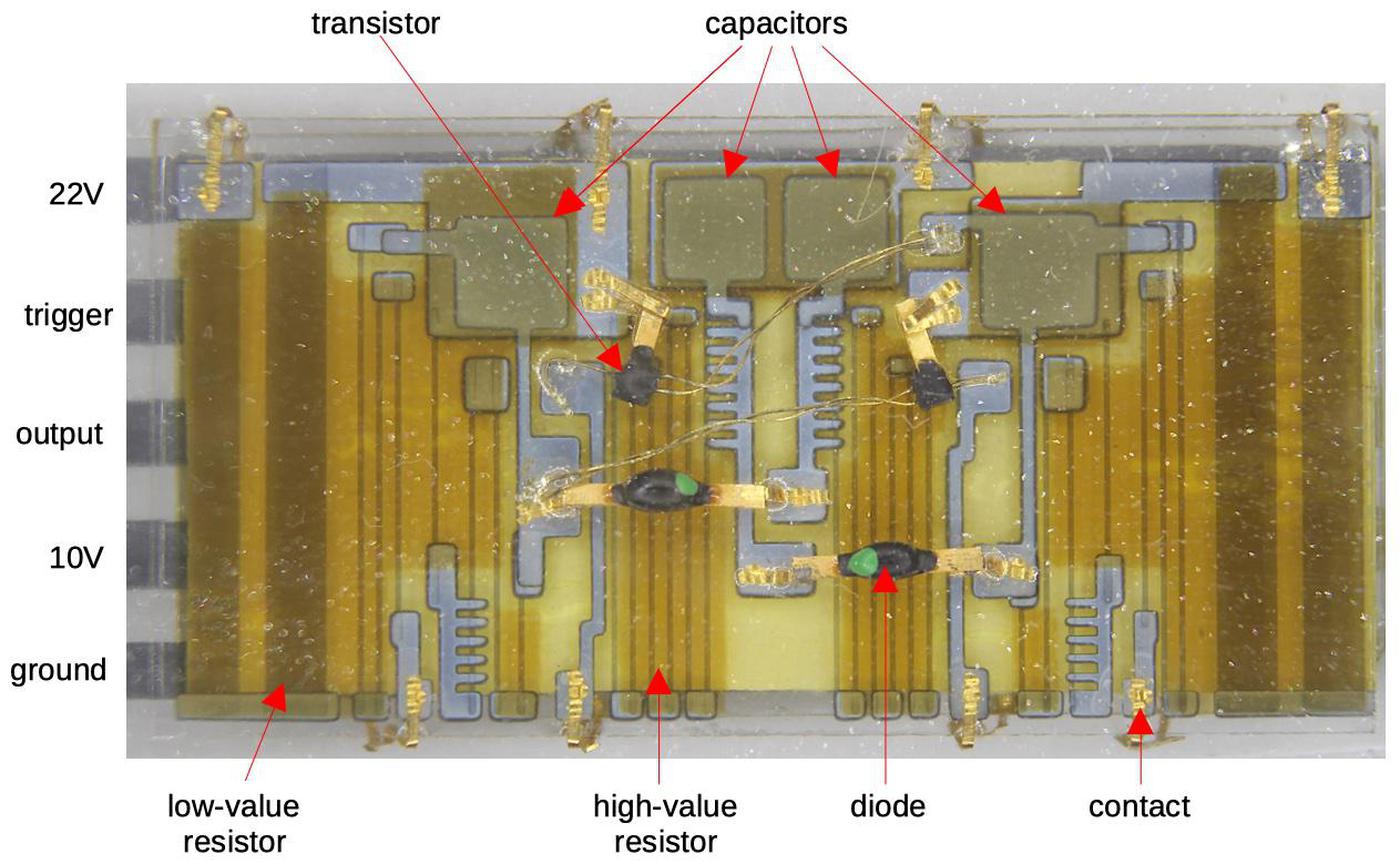
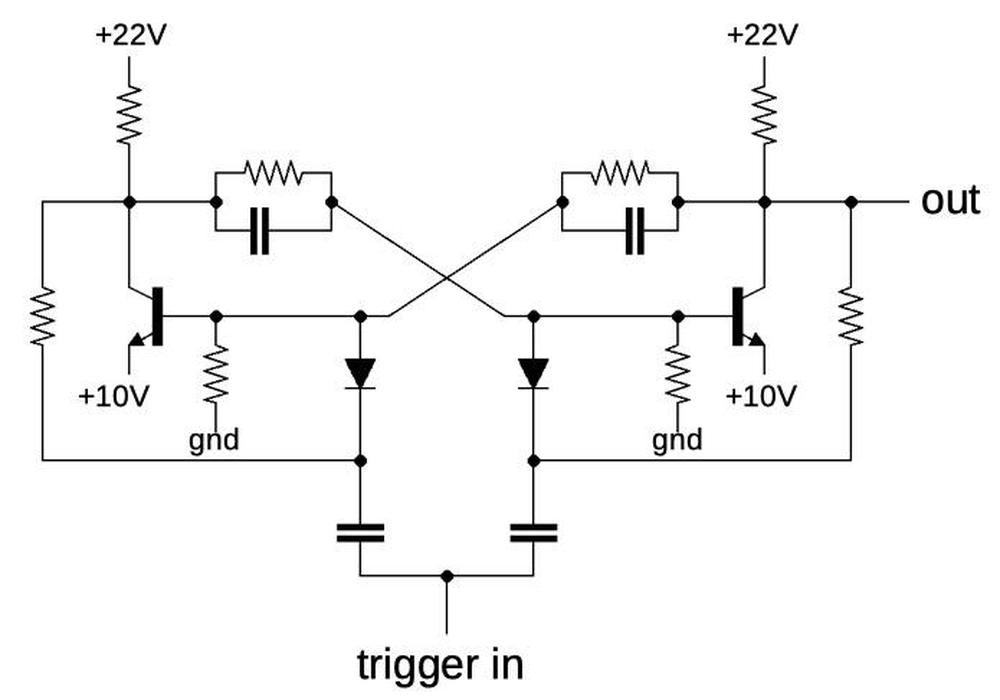
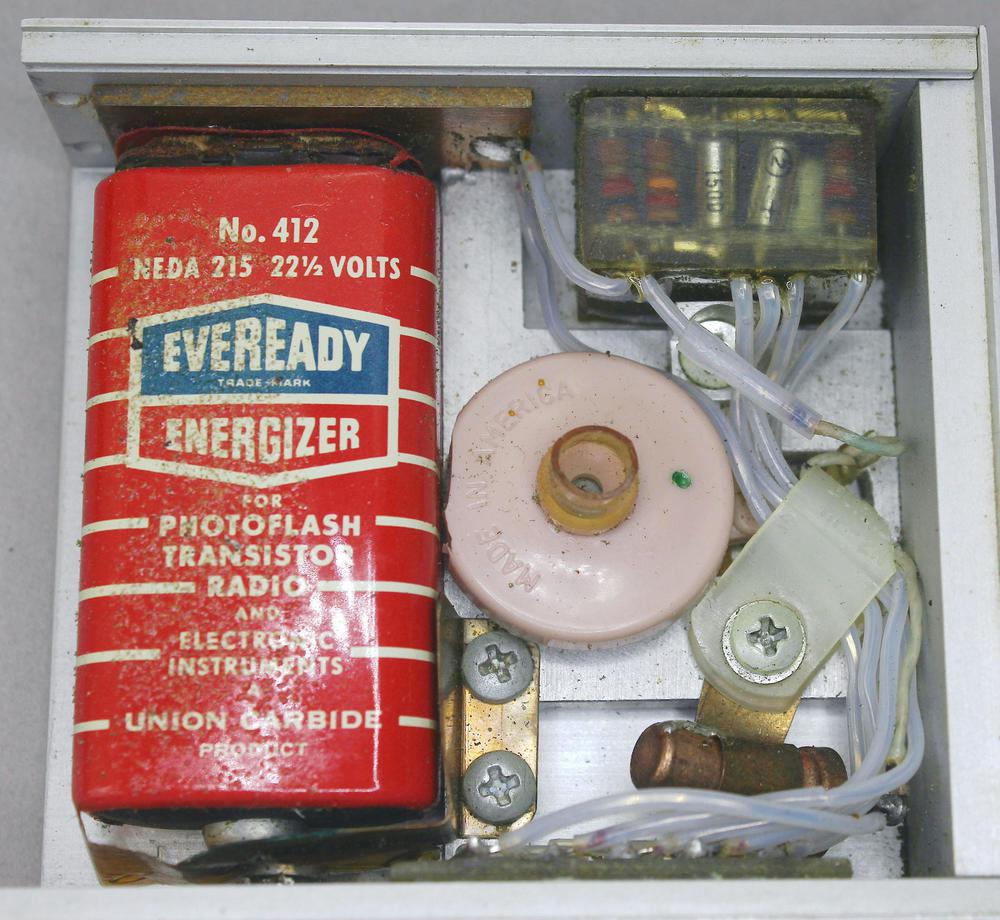
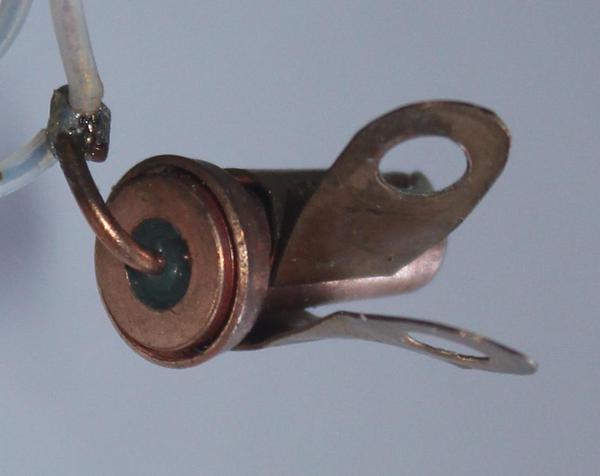
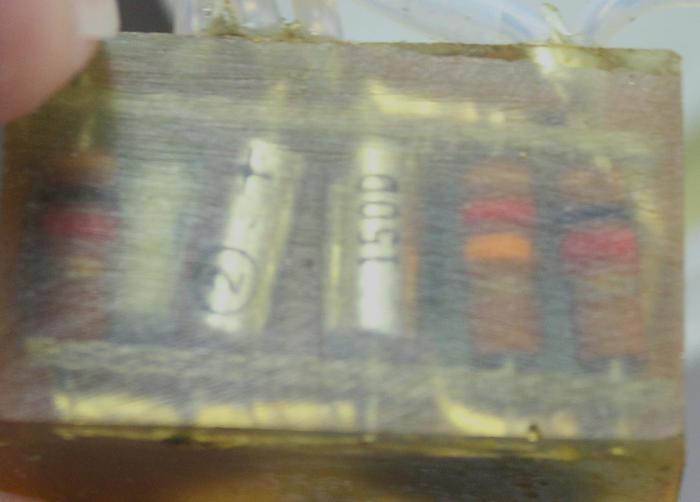
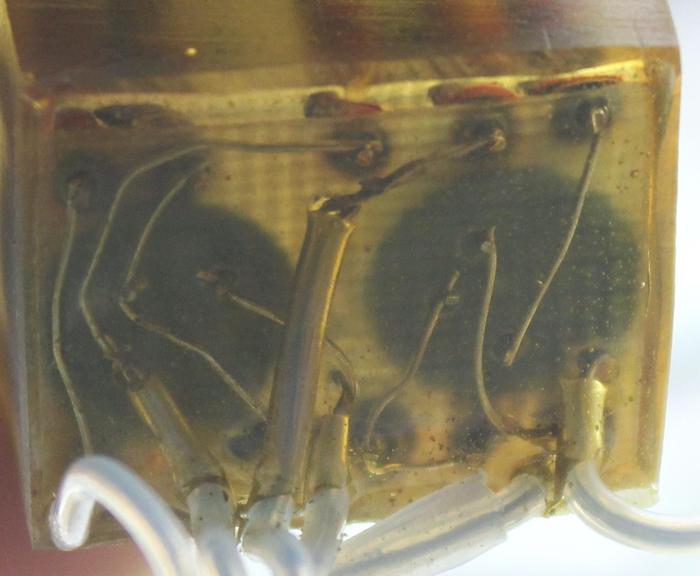
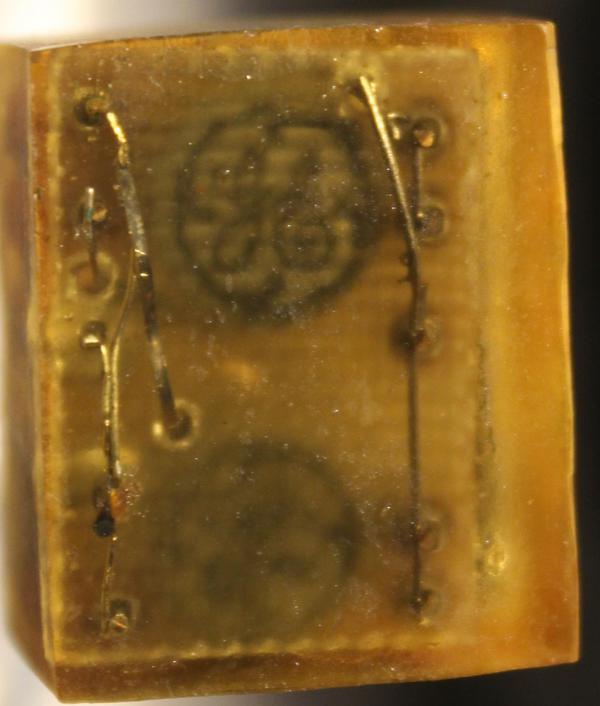
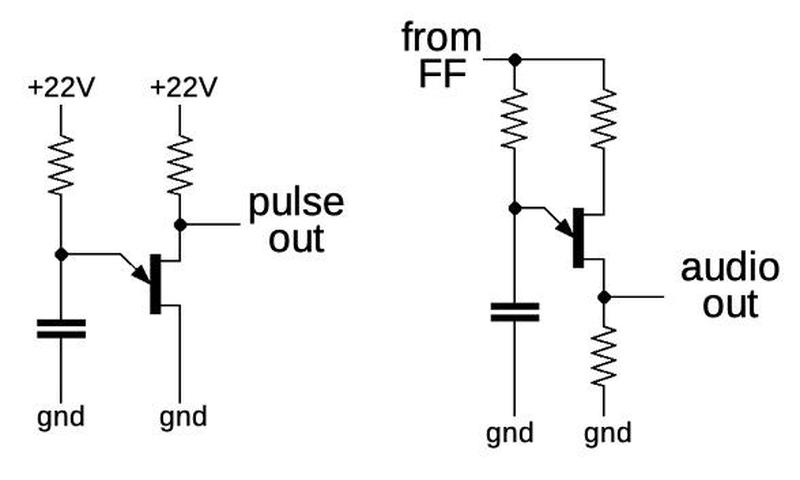
6 comments:
The first American in orbit in 1962 was John Glenn, Shepard made a suborbital launch in 1961.
Thanks zoomx, I've fixed that .
If only they could have integrated one or two LEDs on the thin-film part...
The 1960's Moog synthesizer 901B oscillator used a unijunction transistor. People still rave about its sound - very rich in harmonics.
Interesting that the rather old battery in the paperweight still has enough capacity to work.
BTW, modern versions of that battery are still readily available(rather costly however).
Marc: the old battery was dead and bulging. I powered the paperweight from an external power supply.
Post a Comment